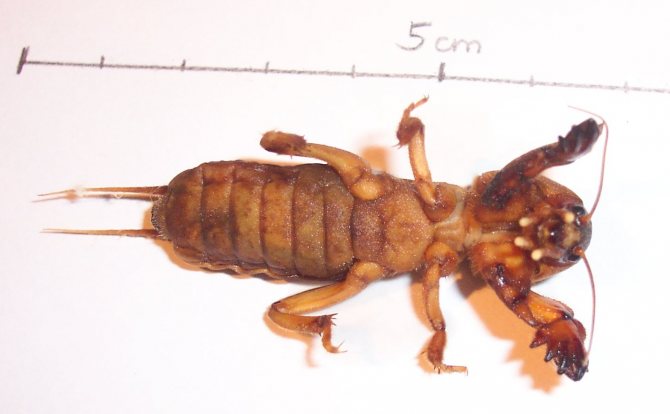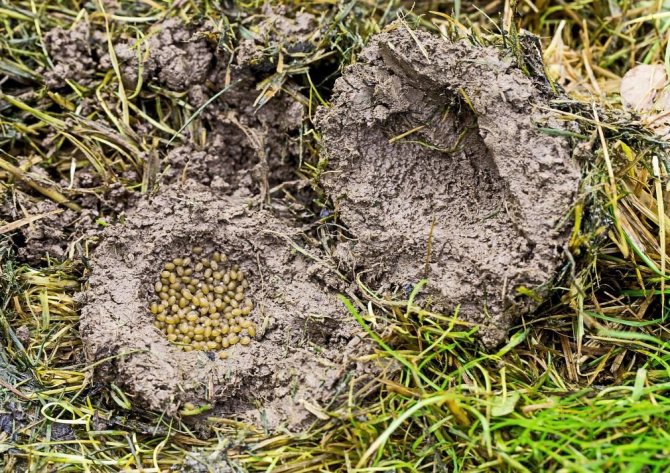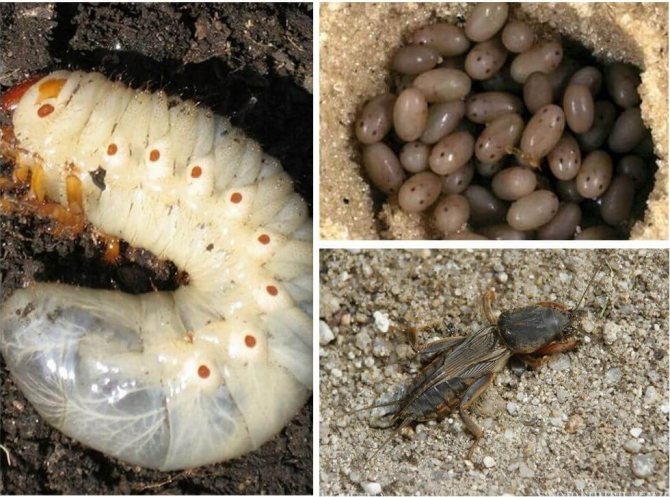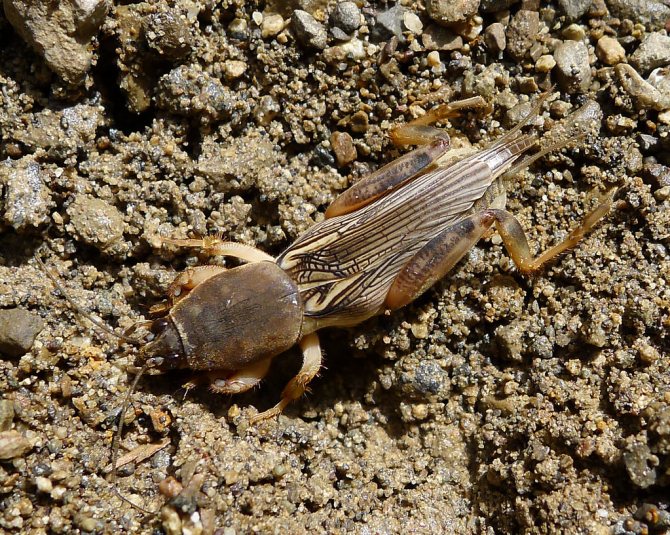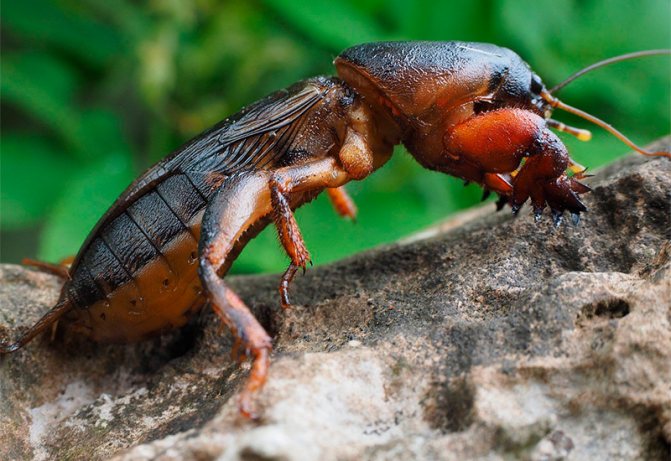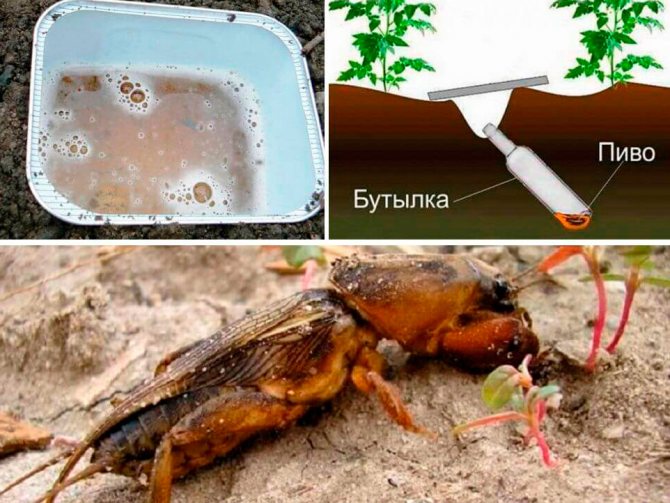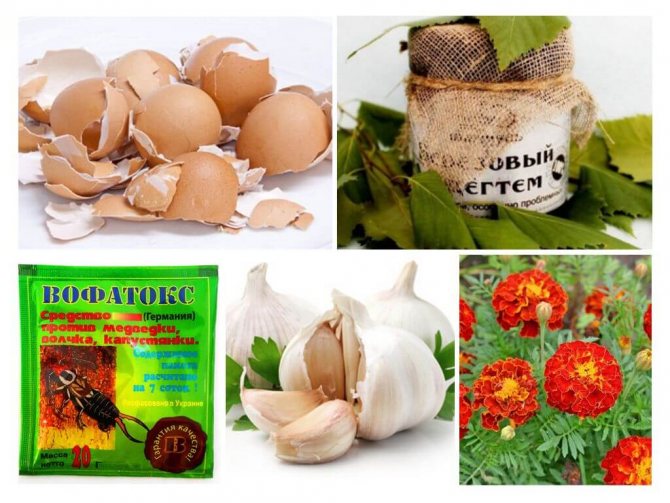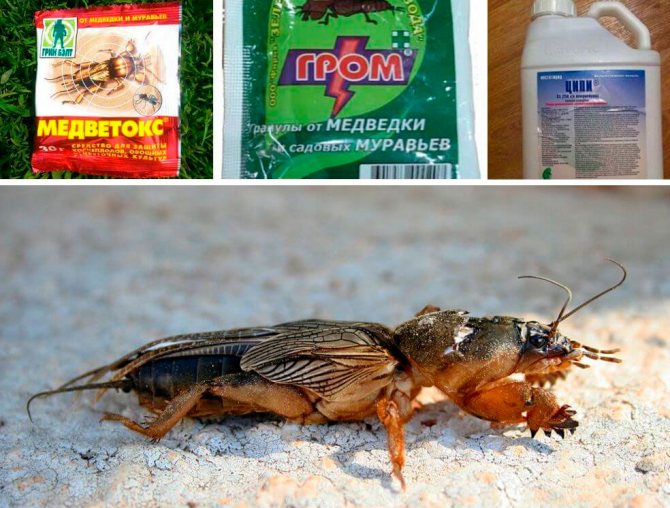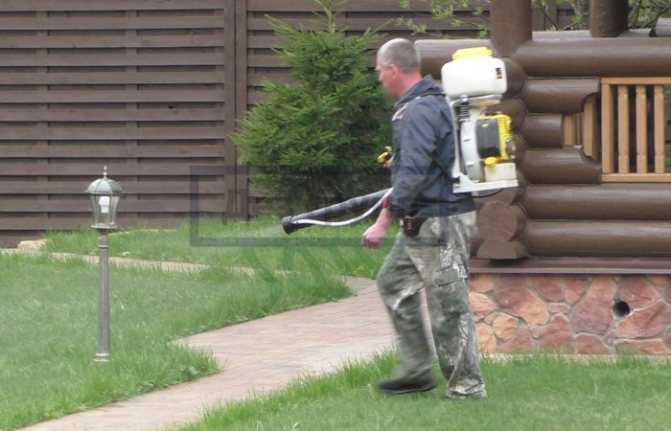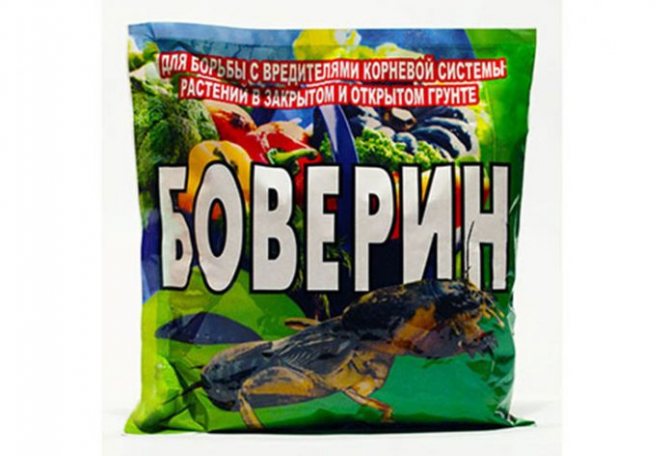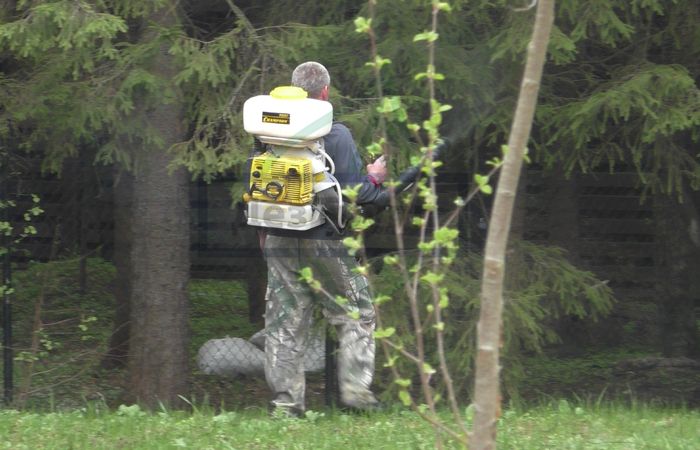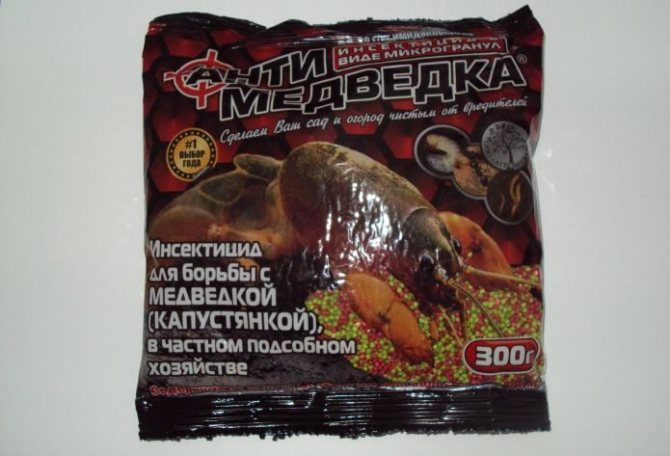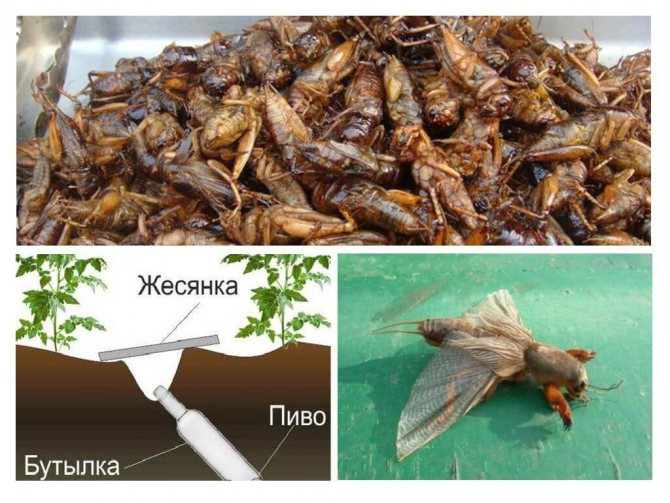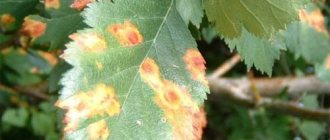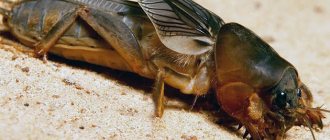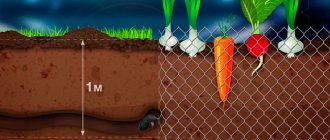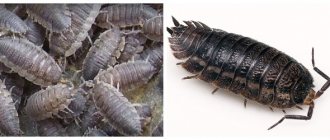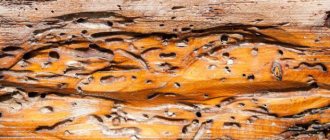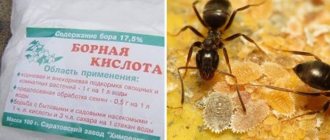How to get a bear out of the garden? She stops at nothing. Indeed, the appearance of this pest in the garden can threaten the complete destruction of the crop. Everything that comes across in her path is subject to destruction. Therefore, it is necessary to start the fight against insects in time. The damage caused by the bear can hardly be overestimated. How to get rid of the bear at the summer cottage once and for all? Is there a remedy that will help defeat the pest?
Of course have!
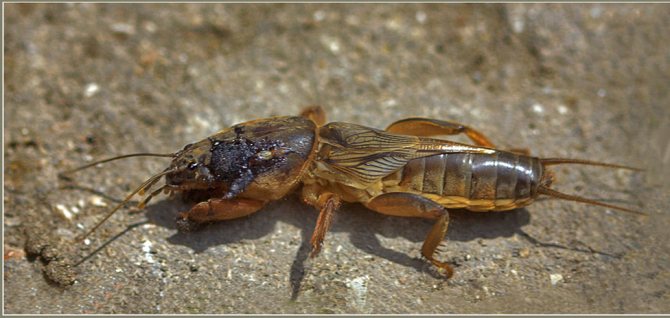
Biological characteristics of the insect and its lifestyle
Medvedka is easy to recognize by its strong claws and short rigid elytra. The length of the insect can be 3.5–6 cm. Pests live underground, making long passages in it. To produce offspring, females need to build an underground nest for the simultaneous development of 100–500 eggs. The larvae emerge from the eggs after about 10 days, and three weeks later they become full-fledged individuals. It is known that the bear eats everything that comes its way: first, it destroys seeds and seedlings, and then feeds on root crops. She does not disdain animal food and occasionally feasts on earthworms.
Bears hibernate in the soil, having previously built burrows at a depth of 60–100 cm. Wintering begins immediately after the temperature drops to 4–6 ° C. It is this cold that makes insects equip their homes. In the spring, after the air warms up to 15–17 ° C, the parasites begin to get out. This period is considered the time of their mass appearance.
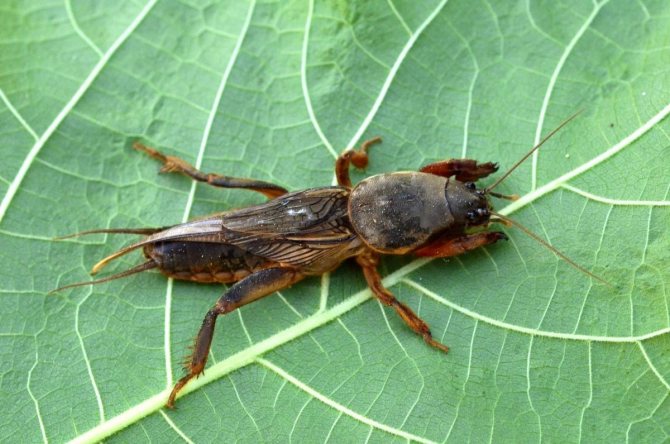

Medvedka: description
It is an orthoptera insect 5 cm in length, there are large individuals 6 cm or more. The body is covered with fine hairs. The cephalothorax is 3 times smaller than the soft, thick, spindle-like abdomen, at the end of which there are cerci - thin appendages. The carapace in the upper torso is hard, like that of crustaceans, and helps to compact the soil when digging tunnels and partially protects the head. It has a mustache, two complexly arranged eyes on the sides, a mouth apparatus with powerful jaws and four tentacles along the edges. The color of the upper part of the chitinous layer is dark and brown, the abdomen has a lighter yellow tint.
The forelimbs with short claws, designed for digging tunnels in the ground, are very different from the rest. Hind legs are rarely used for jumping, however, the bear can climb to a great height of 3-5 meters.
In order to fly, there is a pair of wings with membranes and veins, which, when folded, look like thin bundles and often exceed the length of the body. Above are two short leathery fans that do not participate in the ascent into the air. It is thanks to the friction of these elytra that the insect emits sounds that are audible at a distance of up to 0.5 km. Thus, males invite females to mate. The bear larva does not fly.
Due to the fact that adults quickly move on the surface of the ground and underground, fly, swim and jump high enough, they are considered the oldest insect species on earth. Due to its skills, body structure and nutrition, the pest has several names: cabbage, bear, crayfish or mole cricket. Life expectancy is 3-5 years.
Signs of a pest in the garden
When insects appear in the garden some time later, traces of their presence become noticeable:
- near the plants, horizontal passages are indicated, which are clearly visible after rain or watering;
- drying of young shoots is observed, which can be easily pulled out of the ground. In some cases, they look bitten;
- lesions appear on the tubers in the form of deep bite marks;
- small rounded holes appear in the soil, which serve as entrances for insects to burrows;
- Often, near the damaged plants, you can see the pest itself.
Chemicals
If we talk about how to deal with a bear, then many gardeners immediately resort to chemical methods. The most popular and effective drugs are "Rubit", "Bankol", "Medvetox" and "Regent". All of them are insecticides that localize the work of the central nervous system.
Under the influence of the agent, the insect first loses its ability to move, and then, within two or three days, dies. All of the above drugs have minimal toxicity and do not affect animals and birds. They become most effective when the air temperature rises to 35 ° C.
Basic methods of struggle
The fight should begin in early spring.
When the soil warms up well, at this time the active vital activity of insects begins. And the peak of this activity falls on the period of planting root crops and seedlings.
What I would like to advise gardeners if pests attacked your site. It's better to use chemicals for a start. Although this is not a very useful tool for the soil, as well as for the plantings themselves. But I think that in such a situation there is no need to choose.
The use of drugs:
1. Select the required composition. There are no safe chemicals. Therefore, reduce the concentration as much as possible, depending on the plant.
2. There are drugs that are used before planting.
3. After half a month after planting, the properties of the chemicals will decrease. This means that the bear will be able to damage the plants again. To do this, you need to get poisonous traps in advance.
Preparations that are used in the fight against a bear are such as:
- Medvetoks;
- "Gromoboy";
- "Wafatox";
- "Regent". A pea cut is brewed and mixed with the preparation. Before planting potatoes, grooves are made and bait is laid. After it is covered with earth.
Before planting, seed potatoes should be soaked in Prestige. The Colorado potato beetle also does not tolerate this poison.
The preparation "Bi-2" repels pests with a smell. And if it gets inside an insect, it dies. Ultrasonic scarers are also used. The sound effect of these devices negatively affects insects. Then they, feeling the danger, leave the territory. It is important to note that the fight must be waged in agreement with the neighbors. Otherwise, the pest will return.
Additional measures;
- regularly introduce pesticides into the soil. Thus, the number of insects will be gradually reduced;
- in the fall, before frosts, it is imperative to plow the garden.
Biological preparations
There are other ways how to deal with a bear in the garden. For example, the use of biological products, the composition of which is safe for humans, birds and animals. These products include "Nemabakt" and "Boverin".
The first contains nematodes and bacteria, which, entering the pest's body, eat away at its insides. The drug should be stored in the refrigerator, and transported and put into the ground only when the air temperature exceeds 25 ° C heat. One package is required to process one hundred square meters of a vegetable garden The basis of "Boverin" is the spores of a fungus called Beauveria bassiana.
Under the influence of the drug, the bear develops a disease called muscardino.Fungal spores pierce the insect's cover, as a result of which it dies. Most often, the drug is used when growing seedlings in a greenhouse.
Folk recipes
Many gardeners who know who the bear is and how to deal with it prefer folk remedies. These methods do not guarantee that the insects will disappear from the site. However, they are very popular among the people, since they do not threaten human health at all, besides, with a small number of pests, they really help to get rid of them quickly.
For example, many people use water with ammonia to fight insects. In addition to the fact that the bear is scared off by the pungent smell of this substance, water with ammonia is an excellent fertilizer, due to which the nitrogen content increases in the soil. To prepare the working solution, you will need about 3 tbsp. l. dissolve ammonia in 10 liters of water. The resulting liquid is poured over the roots of plants (0.5 liters for each), trying to prevent the solution from getting on the leaves. There are other effective recipes as well.
Filling holes and passages
This method is fast, affordable and instant results. After pouring a special solution into the holes, the pests crawl out to the soil surface. Most often, soap, washing powder and oil are used to prepare the solution. Soap solution. To prepare a soap solution, you need to grate laundry or tar soap (100 g). Then it must be dissolved in 10 liters of water and stirred well.
The resulting solution should be poured into pest holes. Kapustians that have crawled out on the surface must be immediately destroyed with a shovel or other sharp object. Other insects should die after a while in flooded burrows. Washing powder application. The fight against the bear in the garden with folk remedies is forever possible with the help of washing powder.
To do this, it is necessary to dissolve any washing powder (2 tablespoons) in water (10 l) and pour the resulting solution into the underground tunnels of the pest. After the powder has been absorbed into the ground, which occurs within one to two minutes, the bear crawls out to the surface. It must be destroyed immediately.
This catching method requires quick response and silence!
Butter. This folk method consists in preparing an oil solution and pouring it into bear holes. The liquid is prepared at the rate of 2 tablespoons of sunflower oil per bucket of water. The solution must be poured slowly to allow air to escape from the burrow. After a while, a bear with a clogged airway will appear from it, which will very soon lead to its death.
Trap device
The advantages of traps are in the duration of their effect. They only need to be placed in the garden, and they will work for one to two weeks. The most effective of them, according to summer residents, are traps with beer, honey, manure and shadow traps. A brief description is provided below.
With beer. You can destroy the bear with beer - the insect likes this drink. A bottle of beer (1/3 capacity) should be buried in the ground, making a slight slope. The neck must be left on the surface, covered with an iron sheet and sprinkled with water. After a few days, the trap can be checked: pests will surely fall into it.
With honey. This trap is especially effective in the fall, before the onset of frost. During this period, the insect prepares for wintering, so it tries to find a warm place and good food, which is perfect for honey. To make a trap, you need to coat the jar with thick honey around the edges and on top. The container itself must be covered with a sheet of iron and insulated with straw. Soon the pest will creep up on the fragrant honey smell and warmth.
Shadow. You can get rid of the bear with the help of shadow traps.To do this, you need to lay out pieces of roofing material, plywood or cardboard on your personal plot. It is important that all of these materials are in dark colors. Medvedka likes to bask under them in sunny weather. To increase efficiency, you can make holes under the shelter and put pearl barley or rice porridge in them as bait with the addition of a small amount of unrefined sunflower oil. You need to collect pests twice a day, in the morning and in the evening, quickly raising the shelter and destroying the hiding bear.
If the work is noisy, the insect can hide!
Dung. This method involves spreading small dung cakes over the area. They should lie for several days, attracting pests. Then you need to check each cake for the presence of bears, trapped pests, collect and destroy.
How to use kerosene
A powerful tool used to kill pests is kerosene. A solution of water (10 l) and kerosene (100 g) is poured into the passages of the bear, after which it dies. Also kerosene is used in combination with sand. To do this, add one tablespoon of combustible material to a bucket of sand with a capacity of 10 liters. After thorough mixing, the mixture is laid out along the paths near the beds.
How to use eggshells
You can use eggshells as bait for the bear. It needs to be dried, chopped and added with a little sunflower oil (preferably homemade). Experienced gardeners advise putting the resulting mixture in holes for sowing seeds or planting seedlings. The pest will definitely try this "delicacy", which will soon lead to his death. In addition, the remaining shells are a good fertilizer. Therefore, this method is both safe and useful.
Scare away smells
Since cabbage can not tolerate some strong odors, there are methods based on this feature. All of them are designed for pest control in small areas. What plants can be used. Marigolds, which are sown together with garden crops, are good at repelling pests.
Many gardeners use fresh alder branches, spreading them about 1.5 m apart. Periodically they need to be changed to more recent ones. The territory infected by the bear can be poured with onion infusion in the summer, for the preparation of which it is necessary to pour the husk and onion waste (900 g) with water (10 l) and leave for 4-6 days. Before use, the infusion must be diluted with water in a ratio of 1: 5 and the resulting solution should be watered 2–4 times at intervals of 5–8 days. The procedure should be performed after rain or watering.
Needles and aspen. Medvedka does not tolerate coniferous odors. Knowing this feature of pests, gardeners spread spruce branches between rows. To keep the aroma as long as possible, sprinkle each branch with earth. The bear and the aspen are afraid, so many use it to drive out pests. To do this, make small aspen stakes, about 30 cm in length. They are driven in in places of mass accumulation of insects. The distance between the stakes should be one meter. The bark does not need to be cleaned as it retains the smell.
Arrangement of obstacles
Medvedka is not able to overcome some obstacles, and you can use this to protect plants in the country from imminent death:
- Using plastic bottles, you can make a kind of fence with a height of at least 2 cm or block the area with a fine mesh fence.
- The stem of the seedling can be protected by putting on a short (about 2 cm) rubber tube (you must first make a cut along its length).
- During planting of plants, their roots can be wrapped in a nylon netting.
A good way to protect against cabbage is to mulch the beds with straw or hay. Thanks to the light material, the earth will not get very hot. And this will not please the heat-loving pest.
How to get rid of a bear in the garden using chemicals
Interested in how to get rid of the bear on the site? The most effective way is with pesticides. This is a radical method of struggle, to which summer residents turn to when folk remedies are ineffective.
To combat the bear, pesticides are used: "Aktara 25 WG", "Prestige", "Medvetox", "Thunder" and "Phenoxin plus". These products are available in the form of powder, granules or liquid. For the destruction of pests, use also biologically active substances - "Boverin", "Nemabakt", etc.


Poisonous chemicals have a poisonous effect on the body of insects, which leads to their inevitable death
The procedure for using chemicals:
- Read the instructions on the packaging carefully.
- Determine the place of the last activity of the pest (the most recent moves).
- Place poison pellets in burrows. When spreading the poison, cover it well with earth to limit the access of pets or birds to it.
- In order to increase the likelihood of attracting a bear to poison, make bait from fresh manure.
When working with pesticides, do not neglect safety measures. Be sure to wear rubber gloves, avoid inhalation of chemicals, contact with skin or mucous membranes. Keep children and pets away from the poison.
Prophylaxis
To reduce the appearance of a bear in your summer cottage to a minimum, you must:
- Clearing the area from branches, fallen leaves and other debris - after harvesting, it will be much easier to detect and destroy the pest.
- Before sowing the plants, it is advisable to treat the seeds with "Aktara".
- Not far from the site, you can plant calendula or chrysanthemum, the smell of which scares off cabbage.
- In order for insects to freeze out during cold weather, it is necessary to make a deep digging of the soil in late autumn.
A source


